Imagine juggling multiple versions of documents, tracking changes through endless email threads and ensuring that everyone is working on the most up-to-date file. The process isn't only time-consuming but also prone to human error, which can lead to confusion and delays in task completion.
That’s where Document Control Software steps in as a game-changer by automating and streamlining these processes. It eliminates the chaos of manual tracking by providing a centralised system for version control and ensuring that everyone has access to the latest document.
In fact, the Document Control Software market is expected to reach $48.98 billion by 2036.
In this blog, we'll talk about how Document Control Software reduces the risk of errors and speeds up review processes. Plus, we bring you a one-step solution, through which you can create your dream Document Control Software and empower your organisation.
What is document control?
Document control is a set of procedures used to manage and track documents throughout their lifecycle. It begins from creation and approval to distribution, revision and archival. The goal of these document control procedures is to make sure that documents are accurate, up-to-date and accessible to those who need them.
Key aspects of document control
The key aspects of document controls include 👇
- Document creation and approval - establishing a standardised process for creating and approving documents to maintain consistency and accuracy.
- Version control -keeping track of different versions of a document to ensure that everyone is working with the most current version.
- Document distribution - managing how documents are shared, often through controlled distribution lists or document management systems.
- Revision management -tracking changes made to documents, including who made the changes, when they were made and why.
- Archiving and retention - storing documents securely and ensuring they're retained for the appropriate amount of time.
- Access control - controlling who has access to specific documents to maintain confidentiality and integrity.
What are Document Control Systems?
Document Control Systems are software solutions designed to automate and streamline the management of documents throughout their lifecycle. These systems help organisations maintain control over their documents. In addition to helping to manage security and compliance, it offers solutions for document creation, approval, version control, distribution, revision and collaboration.
Why should your company use Document Control Systems?
Implementing a Document Control System can bring numerous benefits to your company. Here are some compelling reasons why you should consider using one:
Improved organisation and accessibility
Document control system provides a centralised repository for all your company's documents, making it easier to find, access and manage them.
Paperless approvals
DCS streamlines paperless approvals by digitising workflows, allowing documents to be reviewed and approved electronically. This not only reduces paper usage but also enhances efficiency and security through electronic signatures, ensuring compliance
Enhanced version control
With automatic version tracking, you can ensure that everyone is working with the most current version of a document. This reduces confusion, duplicated efforts and errors.
Streamlined workflows
Automating approval processes and workflows route documents to the right people at the right time. This speeds up review and approval cycles and improves overall efficiency.
Better collaboration
Document Control Systems allow multiple users to collaborate on documents in real-time, with full visibility into changes and comments. This fosters better teamwork and communication.
Risk management
DCS enhances risk management by ensuring that critical documents are securely stored, easily accessible and consistently updated. It provides version control, audit trails, and compliance tracking, which help identify and mitigate risks associated with document mismanagement and non-compliance.
Document Control System examples
Here are some examples of Document Control Systems that are widely used in various industries.
- Manufacturing -Systems like MasterControl, Documentum and Arena PLM are used to manage product specifications, quality control documents and standard operating procedures (SOPs). They ensure compliance with regulations.
- Healthcare - systems like Hyland's OnBase, M-Files and OpenText are employed to handle patient records, clinical trial documents and regulatory submissions. These systems help in maintaining compliance with healthcare regulations.
- Finance -platforms like DocuWare, Alfresco and iManage are utilised for managing financial reports, contracts and compliance documents. They ensure adherence to regulations like Sarbanes-Oxley and GDPR.
- Education -platforms like Google Drive, Microsoft OneDrive and Blackboard are used to manage course materials, student records and administrative documents. They help in maintaining compliance with educational standards and data privacy laws.
What industries can benefit from a Document Control System?
Different industries could benefit from Document Control Systems. Let’s learn about them briefly here. 👇
Healthcare
In the healthcare industry, it ensures adherence to regulations like Health Insurance Portability and Accountability Act (HIPAA) by managing patient records securely.
Secondly, it also works in streamlining the management of medical records, clinical trials and research documents.
Finance and banking
Document Control Systems work in managing financial reports, auditing and regulating documents. It also secures the handling of sensitive financial information, organising legal documents, contracts and case files.
Manufacturing
In manufacturing industries, it works with quality control involves looking at Standard Operating Procedures (SOPs), quality manuals and product specifications. It also ensures compliance and adherence to international standards and other regulatory requirements.
Education
In the education industry, it works by managing curriculum, organising lesson plans, syllabi and educational materials. Additionally, it also makes sure that the curriculum is according to educational standards and regulations.
Software and tech industry
Document Control Systems in the tech and software industry adheres version control and traceability, crucial for managing source code, design documents and project specifications. They facilitate collaboration and streamline review processes, enabling teams to work efficiently on complex projects.
Difference between Document Control Systems & Document Management Systems
Document Management Systems (DMS) focus on the storage, organisation and retrieval of documents, providing a central repository for easy access and collaboration.
In contrast, Document Control Software emphasises the control and compliance aspects, including version control, approval workflows and audit trails to ensure documents meet regulatory and quality standards.
Document Control Systems | Document Management Systems | |
Primary Focus | Ensuring compliance and control over document lifecycle | Managing and organising documents for accessibility and collaboration |
Core Functionality | Core Functionality Version control, approval workflows, audit trails, compliance | Storage, retrieval, indexing, search, collaboration |
Compliance | High focus on regulatory compliance and industry standards | May include compliance features, but not the primary focus |
Approval Workflows | Automated, detailed approval workflows with notifications | May include basic approval processes, but less detailed |
Audit Trails | Comprehensive audit trails for all document activities | Basic audit trails, often less detailed |
Access Controls | Granular access controls with role-based permissions | Basic access controls, often less granular |
Industry-Specific Features | Often includes features tailored to specific industries | More general features, less industry-specific |
How does a Document Control System work?
Create robust custom software today
100s of businesses trust us to help them scale.
Book a demoBy proceeding you agree to Builder.ai’s privacy policy
and terms and conditions
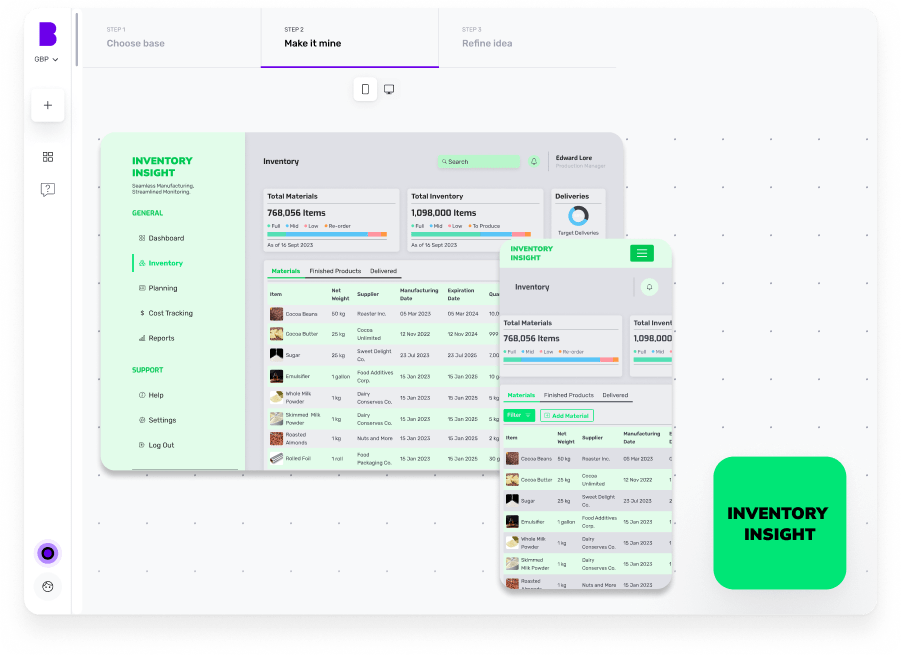
A Document Control System works by providing a structured and automated way to manage documents throughout their lifecycle, from creation to archival.
Here's a step-by-step breakdown of how a Document Control System typically works:
Step 1 - Document creation
Users create new documents within the system or upload existing ones. Further, the system provides templates to maintain consistency and compliance with organisational standards.
Step 2 - Metadata assignment
Users can add relevant metadata (eg, document title, author, department, keywords, etc.) to make documents easily searchable.
Step 3 - Version control
The system automatically assigns a version number to each new document to track changes and maintains a history of previous versions. This allows users to revert to earlier versions if needed.
Step 4 - Workflow and approval
Once the draft is ready, the system routes documents for review and approval.
Step 5 - Access control
Administrators set permissions for who can view, edit or approve documents in the system. This makes sure that only authorised users can access specific documents or perform certain actions.
Step 6 -Document distribution
Once approved, documents are published and made available to relevant users or groups. The system may provide notifications to alert users of new or updated documents.
Step 7 - Search and retrieval
Users can search for documents using keywords, metadata or other filters for it to display the most relevant results.
Step 8 - Revision and update
When a document needs to be revised, users can check it to make edits and track changes.
Step 9 - Archival and retention
The system automatically archives documents based on predefined retention policies. These archived documents can be retrieved if needed.
Step 10 - Reporting and auditing
The system generates reports on document activity, approval status and other metrics. It maintains audit trails to support compliance and facilitate internal or external audits.
Who is a document controller?
A document controller is a professional responsible for managing and overseeing the document control processes within an organisation. Their primary role is to ensure that documents are accurately created, approved, distributed, revised and archived in compliance with relevant standards or regulations.
How Document Control Software ensures compliance?
Document Control Software ensures compliance through several key features and functionalities designed to help organisations meet regulatory requirements and industry standards.
Centralised document storage
By providing a single, secure repository for all documents, Document Control Software ensures that everyone in the organisation is working from the same set of information. This reduces the risk of outdated or non-compliant documents being used.
Version control
Automatic version control tracks changes made to documents, ensuring that only the most current, approved version is accessible. This helps prevent the use of outdated information and maintains a clear audit trail of document history.
Access controls
Access controls allow administrators to set permissions for who can view, edit or approve documents. This authorises individuals to access or modify sensitive or regulated information.
Automated workflows
Document Control Software can automate review, approval and distribution processes, ensuring that documents follow a consistent and compliant lifecycle. This includes routing documents to the right people at the right time and sending notifications for pending tasks.
Audit trails
Detailed audit trails track all document activity, including creation, modification, approval and access. This provides a complete history for auditing purposes and helps demonstrate compliance to regulatory bodies.
What you should look for in Document Control System software?
When evaluating Document Control System software, consider the following key features and capabilities to meet your organisation's needs.
1.Version control - the system tracks and manages different versions of documents, preventing confusion and maintaining a clear history of changes.
2.Access control - check for customisable user permissions to control who can view, edit or approve documents, enhancing security and compliance.
3.Workflow automation - look for software that supports automated approval processes and workflows to streamline document reviews and sign-offs.
4.Compliance features - the system facilitates compliance with relevant industry standards and regulations, by providing audit trails and reporting tools.
5.Integration capabilities - assess how well the software integrates with other tools and systems used in your organisation, such as quality management systems.
6.User-friendly interface - prioritise software with an intuitive and easy-to-use interface to encourage user adoption and reduce training time.
7.Scalability - consider whether the system can scale to meet the growing needs of your organisation, handling increased document volumes and user numbers.
8.Security -evaluate the software's security features, including encryption, backup, recovery options and data privacy controls.
Can Document Control Systems be automated?
Document Control Systems can indeed be automated, and automation is one of their key benefits. This would help reduce manual errors and ensure compliance with regulatory requirements. Here are some ways Document Control Systems can be automated 👇
Workflow automation
Automated workflows can route documents through predefined approval processes, sending notifications to the relevant parties and tracking progress at each stage. This makes sure that documents are reviewed and approved in a timely and consistent manner.
Version control
Automatic version control tracks changes made to documents, ensuring that only the most current, approved version is accessible. This helps prevent the use of outdated information and maintains a clear audit trail of document history.
Scheduled reviews and expirations
Automated reminders can be set up for document reviews and expiration dates, ensuring that documents are kept up-to-date and that outdated information is promptly removed from circulation.
Metadata management
Automatic extraction and application of metadata can enhance document searchability and organisation. This ensures that documents are properly categorised and easily retrievable.
Retention and disposal policies
Automated retention policies can check that documents are kept for the required period and then securely disposed of when no longer needed. This helps meet data retention regulations.
Audit Trails
Automated audit trails track all document activities, including creation, modification, approval and access. This provides a complete history for auditing purposes.
How Builder.ai helps you develop Document Control Software
Building software for your business is a complex job that requires meticulous planning, expert development and continuous maintenance.
It also involves understanding intricate business processes, integrating various technologies and ensuring seamless user experiences.
All of these requirements would need a team of software engineers and a lot of time, which might not be cost-effective for your venture.
But, worry not!
As promised, we have brought you a Document Control Software - Builder.ai. Our platform shall cater to your unique and tailored business needs without writing a single line of code.
How does this happen?
Around 80% of all software is made up of around 650+ features. We package each basic feature as a reusable Lego-like block. Explain your idea to our AI companion, Natasha, and she uses these blocks to rapidly create an outline of your software.
The work is completed faster and cheaper because Natasha handles all the repetitive coding. Then it’s off to our software design team and software developers. They personalise it and create any bespoke elements you need.
To build your software, simply head over to Builder Studio. The Builder Studio platform has been built with user convenience in mind and intuitively guides you through the software creation process.
Here’s how you can build your custom software in no time 👇
1 - Discuss your ideas with Natasha
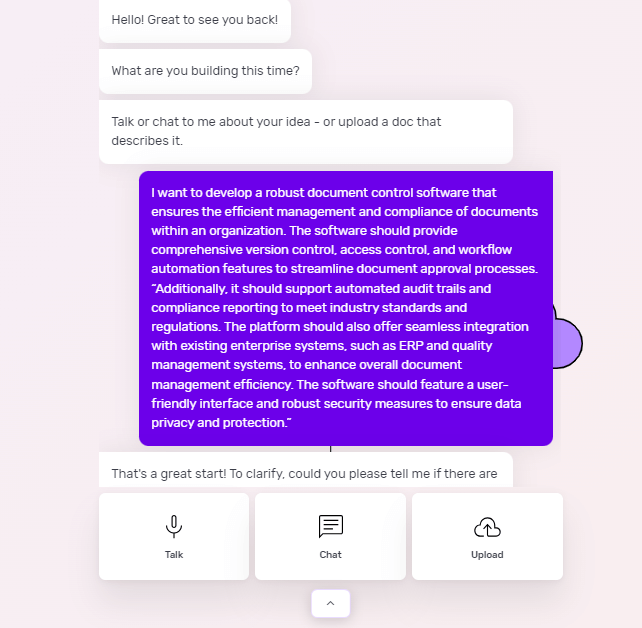
On Builder Studio 4.0, you’re welcomed by Natasha. You can express your software ideas to Natasha via voice, text or uploading a PDF or doc file.
Before you chat with her, have a checklist of software features and be as descriptive as possible about your software idea. The more detailed information you give Natasha, the better her suggestions will be.
Alt: A screenshot of the Builder Studio dashboard highlights Natasha's chat screen where a user tries to build a document control software.
For instance, if you’re building a Document Control Software, your prompt could look like this:
“I want to develop robust Document Control Software that ensures the efficient management and compliance of documents within an organisation. The software should provide comprehensive version control, access control and workflow automation features to streamline document approval processes.
Additionally, it should support automated audit trails and compliance reporting to meet industry standards and regulations. The platform should also offer seamless integration with existing enterprise systems, such as ERP and quality management systems, to enhance overall document management efficiency. The software should feature a user-friendly interface and robust security measures for data privacy and protection.”
Based on your prompt, Natasha will ask you some supporting questions and you simply need to answer them based on your requirements.
2 - Choose a base
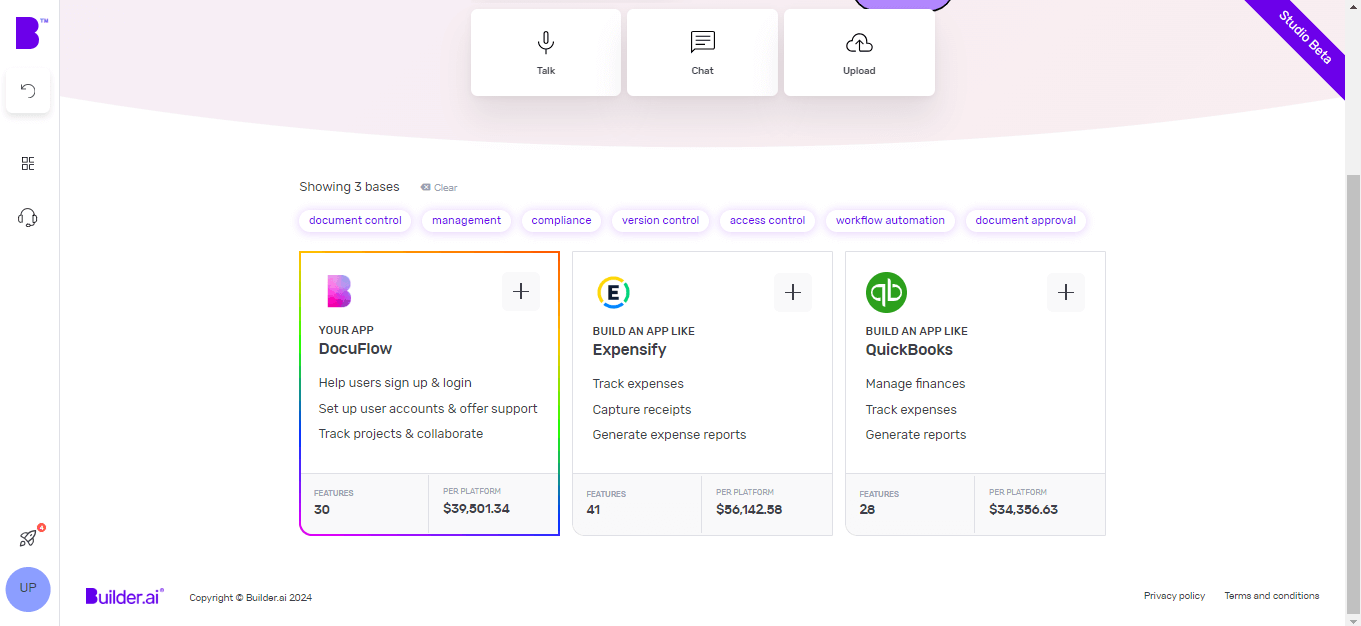
Once Natasha has your requirements, she’ll create a custom framework for your software based on everything you tell her. She'll also suggest some pre-built bases she thinks are best suited for your software.
Continuing from the above Document Control Software example, once you tell her to create a Document Control Software she’ll suggest a custom base and share any matching core bases as well.
You can choose up to 3 you feel are related to your software idea by simply clicking the ‘+’ icon. These selections make it easier for us to understand the features your software needs. When you’re ready, click 'Next'.
3 - Make it mine
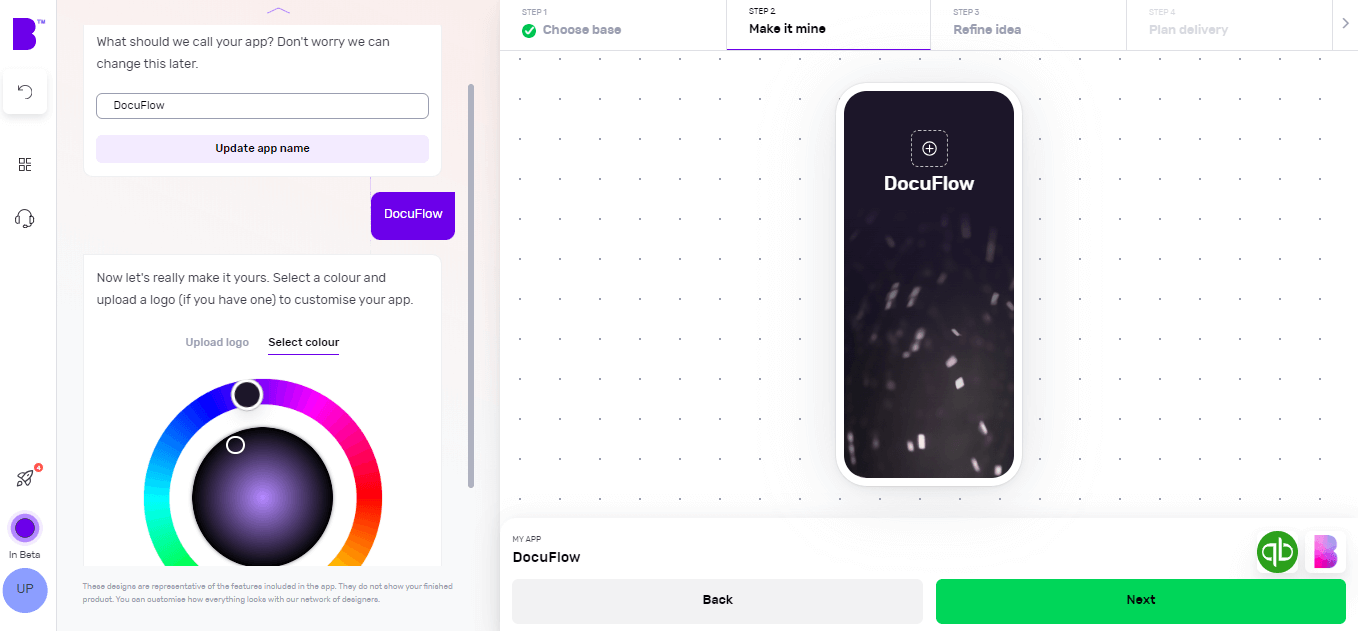
The 'Make it mine' step aligns your software with the identity of your brand. In this step, you provide your software’s name, choose the colour scheme using the colour wheel and upload the logo of your brand.
Once you’ve personalised your software’s name, colour and logo, you can click ‘Next’.
4 - Refine your software idea
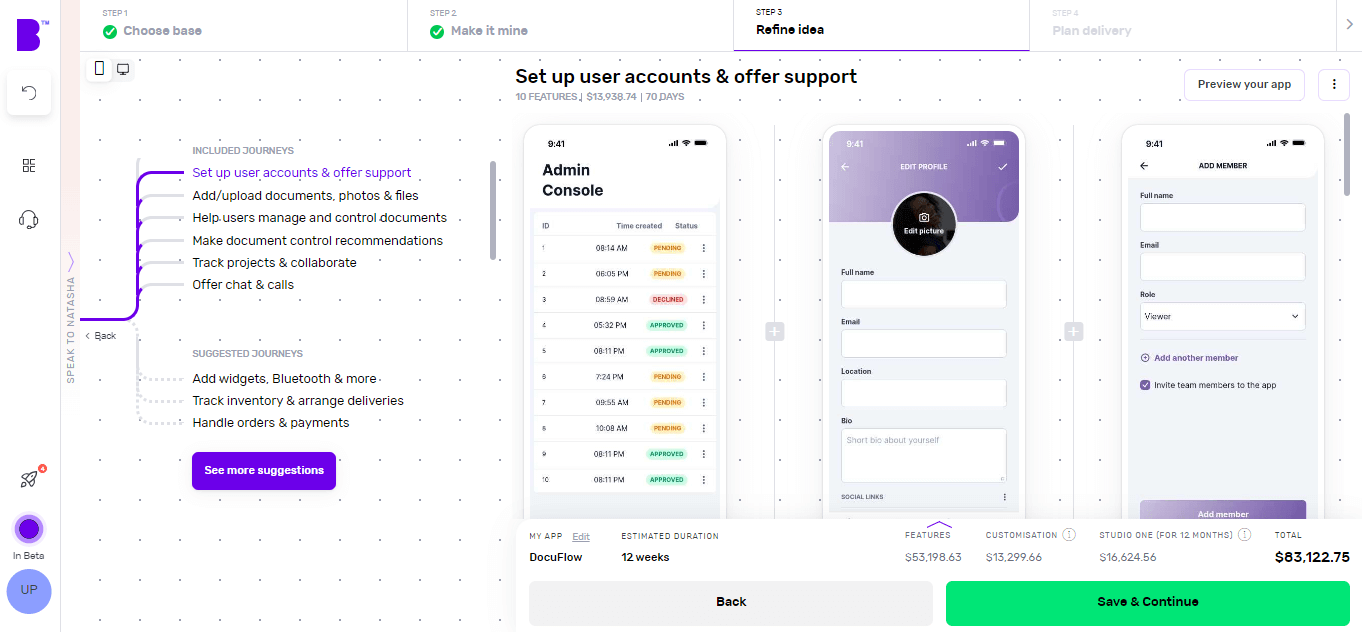
Now comes the fun bit.
In the 'Refine idea' stage, you can review and customise your software journeys and features and also create an instant prototype of your software.
Journeys
In only a matter of seconds, Natasha createssoftware user journeys with corresponding features.
Go through these journeys carefully and see if your software needs additional journeys. For instance, check if you want to add journeys for tracking logistics, customised order status or any other relevant journey.
To add journeys, click on 'See more suggestions'. Doing so will open the list of pre-built journeys. You can browse the list and select the journeys you’re missing. You can also add custom journeys by clicking on 'Add custom journey'.
Features
By clicking on individual journeys, you can see the feature list each journey contains. Doing so will open the features list each journey contains. You can scroll through the features list and check if a journey contains non-essential features or if you want to add extra features.
To remove a non-essential feature, you can hover over the feature and click ‘Remove’. This way you can manage project costs. If you’re not sure what features to remove, you can click on an individual feature and check the label at the top. We highly recommend keeping the ‘Essential Features’.
In case you want to add more features, you can simply click the ‘+’ button. Here you can go through different categories or use the search bar to look for missing functionality. In case you don’t find the feature you’re looking for, you can also add a custom feature by clicking on 'Add custom feature'.
Instant prototype and user flow
Once you’re happy with the journeys and features of your software, you can create a prototype by clicking on 'Preview your app' in the top-right corner.
Sign up and Natasha will create a working prototype of your software. You can click on the screen at different areas to progress through the journey.
You can also see theuser flow by clicking on the 'Flow mode' at the top of the screen to see how users will interact and navigate within your software.
If you need extra help, Natasha is on hand to help and you can interact with her at any time by clicking on 'Speak to Natasha'.
She’ll provide you with suggestions and help you find features or journeys from the library. Or you can click on 'Book a demo' to talk to our product managers who’ll guide you through your software development journey.
Click on 'Save & Continue' to go to the next step and also to save your progress or it might get lost.
5 - Plan delivery
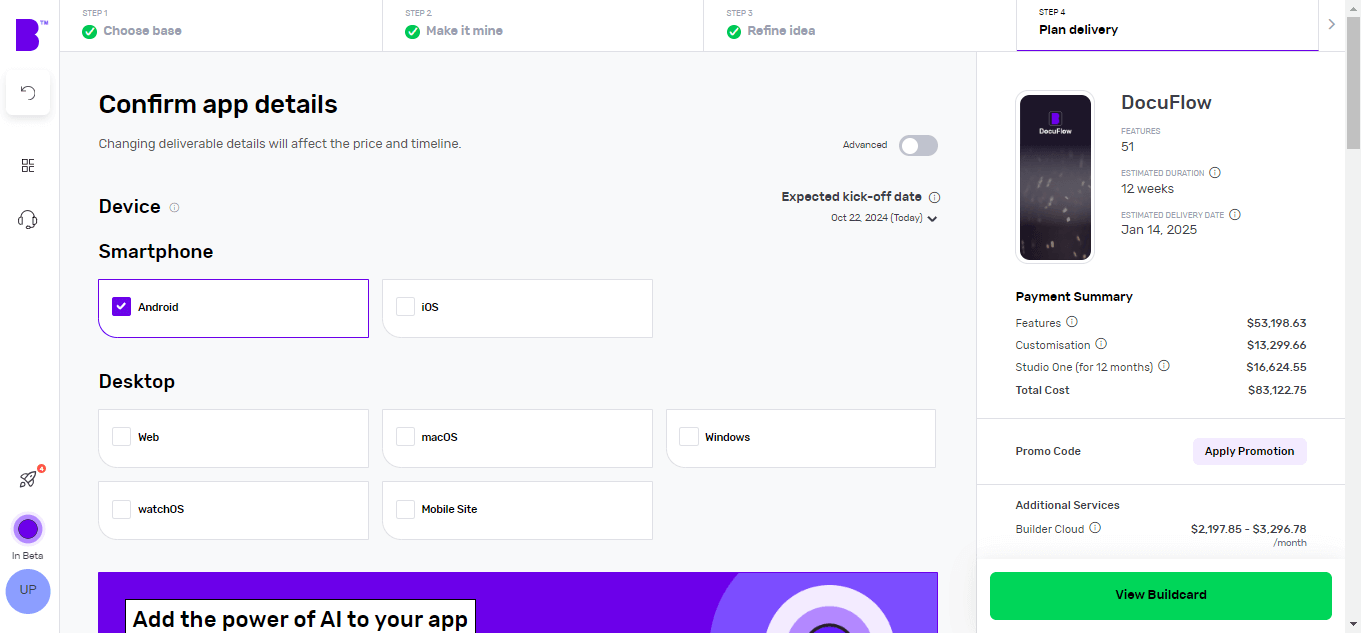
It’s time to choose the platforms you want your software to be available on. Want a desktop app? Click Windows or macOS. Fancy a mobile app? Hit Android or iOS. Not sure about the platform? Choose multiple platforms and see how they change the price and timelines.
Next, you can choose to add Natasha to your platform to supercharge the customer experience of your software. Natasha uses Large Language Models (LLMs) to engage your customers in fluid, human-like conversations.
In the development speed section, you can change the speed of each development phase according to your needs. The faster the development speed, the higher the costs and vice versa.
Next up is Design. If you have your software designs ready, you can save on your costs by clicking 'You have design' and we’ll reduce your costs accordingly. You can share your design files (preferably in Figma) and our designers will upload them, so you can kick them off straight away.
If not, you can choose the 'We do your designs' option. Here, you simply need to add your brand assets and we'll do everything from storyboarding to fully designed screens.
Now it’s time to plan the phases of your project. Here you get 3 options:
- Clickable prototype: you’ll get a visual representation of your software to test with users
- Basic build: you’ll get an MVP (Minimum viable product) – a hard-coded but simplified version of your idea; this allows you to collect feedback and iterate before you do a full build
- Full Build: you’ll get market-ready software, including a kick-off with our product team and review sessions
After that, you need to select your support plans. With 'Full Build' you get one year of Studio One support included free of charge.
Once you’ve planned your delivery, click on 'View Buildcard'.
6 - Review Buildcard
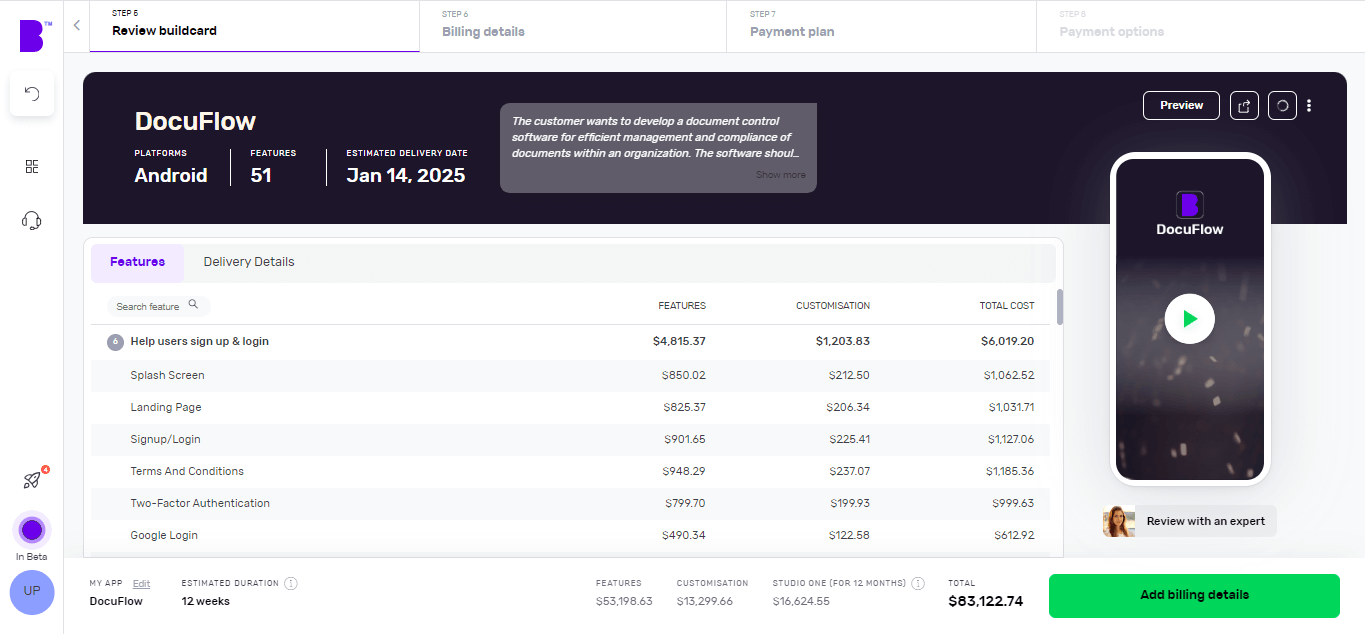
Buildcard provides you with a bird's eye view of all the selections you made in the previous steps. Here, you can review all the features, cost per feature and delivery details.
You can also download the PDF of Buildcard or invite others to show your team members what you’re building.
If you want to make any changes, simply click on 'Edit Buildcard' under the 3 dots in the top-right corner.
If you’re happy with everything, click on 'Add billing details' to go to the next section. Alternatively, if you want to review it with experts, click on 'Review with an expert'.
7 - Select your payment plan
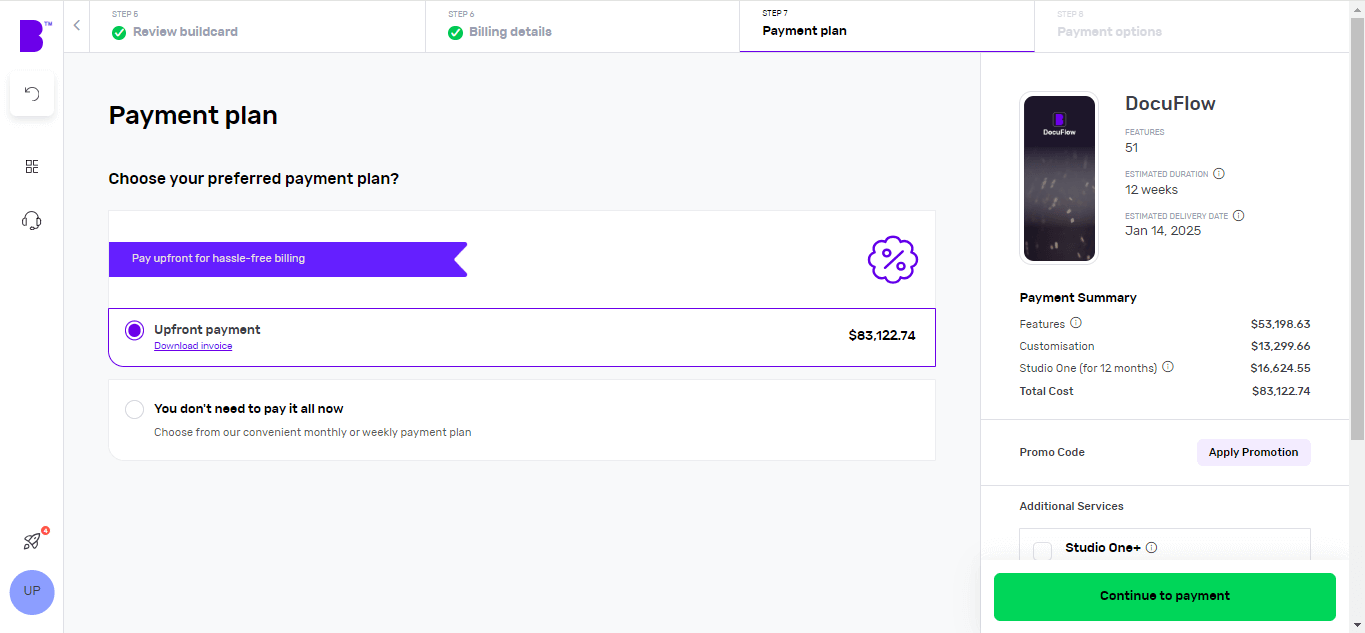
We offer weekly or monthly payment installments, with visible payment dates and amounts for each option. You can also choose to pay upfront to reduce the cost of your build.
Simply select your preferred billing cycle, then click 'Continue' to proceed.
You’ll be asked to input your payment details and agree to the terms and conditions. Once that’s done, click 'Continue to Payment'.
Once your payment is done, you can set up a meeting with our product managers to begin your software development.
8 - Monitor your software build in real-time
With Builder Home, your real-time project dashboard, you can monitor development progress and make sure your software is exactly the way you want it.
This includes access to a suite of collaboration tools to help improve your software design. You can chat with your team of experts in Builder Meet, brainstorm in Builder Whiteboard and visualise your ideas with free Tailor-made prototypes from Builder Now.
Conclusion
If you struggle with managing multiple versions of documents on a regular basis and find it hard to organise your business documents, you need to build Document Control Software.
However, to do this, you need to work with the best in the industry to increase your chances of successfully building high-quality DCS.
Builder.ai’s custom software platform helps you build your software efficiently. We:
✅ - Assign you a dedicated project manager, who keeps all stakeholders on your software project aligned and on track — and you never need to speak to a software developer or write a single line of code
✅ - Speed up development time by giving you access to a comprehensive library of reusable features, fitted together by AI
✅ - Give you upfront costs and competitive timelines so your project stays under control
If that’s something you’d like to explore, click the banner below to start your DCS project today 👇
Create robust custom software today
100s of businesses trust us to help them scale.
Book a demoBy proceeding you agree to Builder.ai’s privacy policy
and terms and conditions

Harsh Priya is a writer at Builder.ai. She has over 3 years of experience in content marketing, spanning across fields like AI, Machine Learning, software, tech, health and lifestyle. With a background in English literature and a fervent passion for research and analysis, Harsh transforms complex concepts into compelling and insightful narratives that educate and drive significant reader engagement.










 Facebook
Facebook X
X LinkedIn
LinkedIn YouTube
YouTube Instagram
Instagram RSS
RSS


